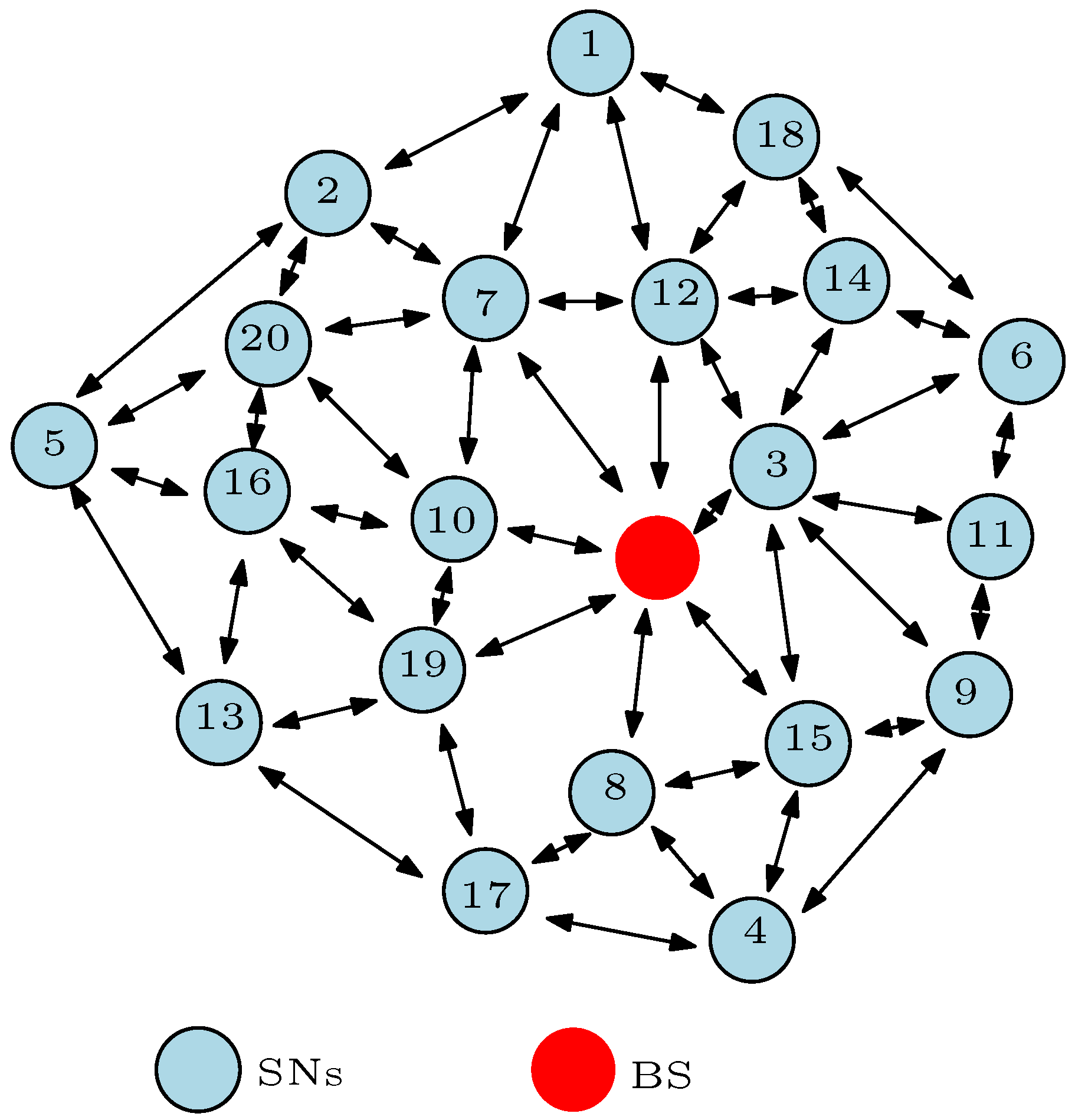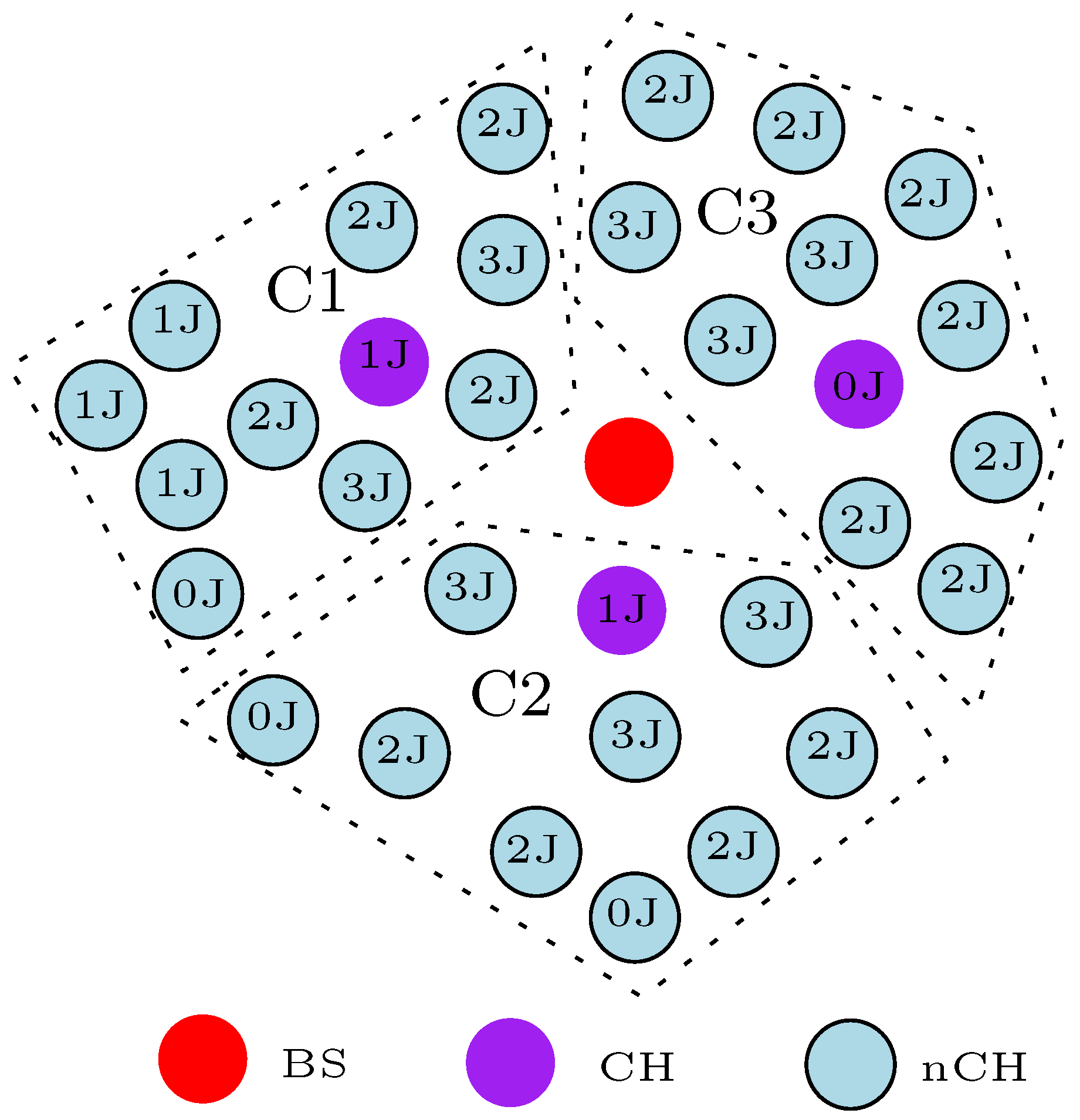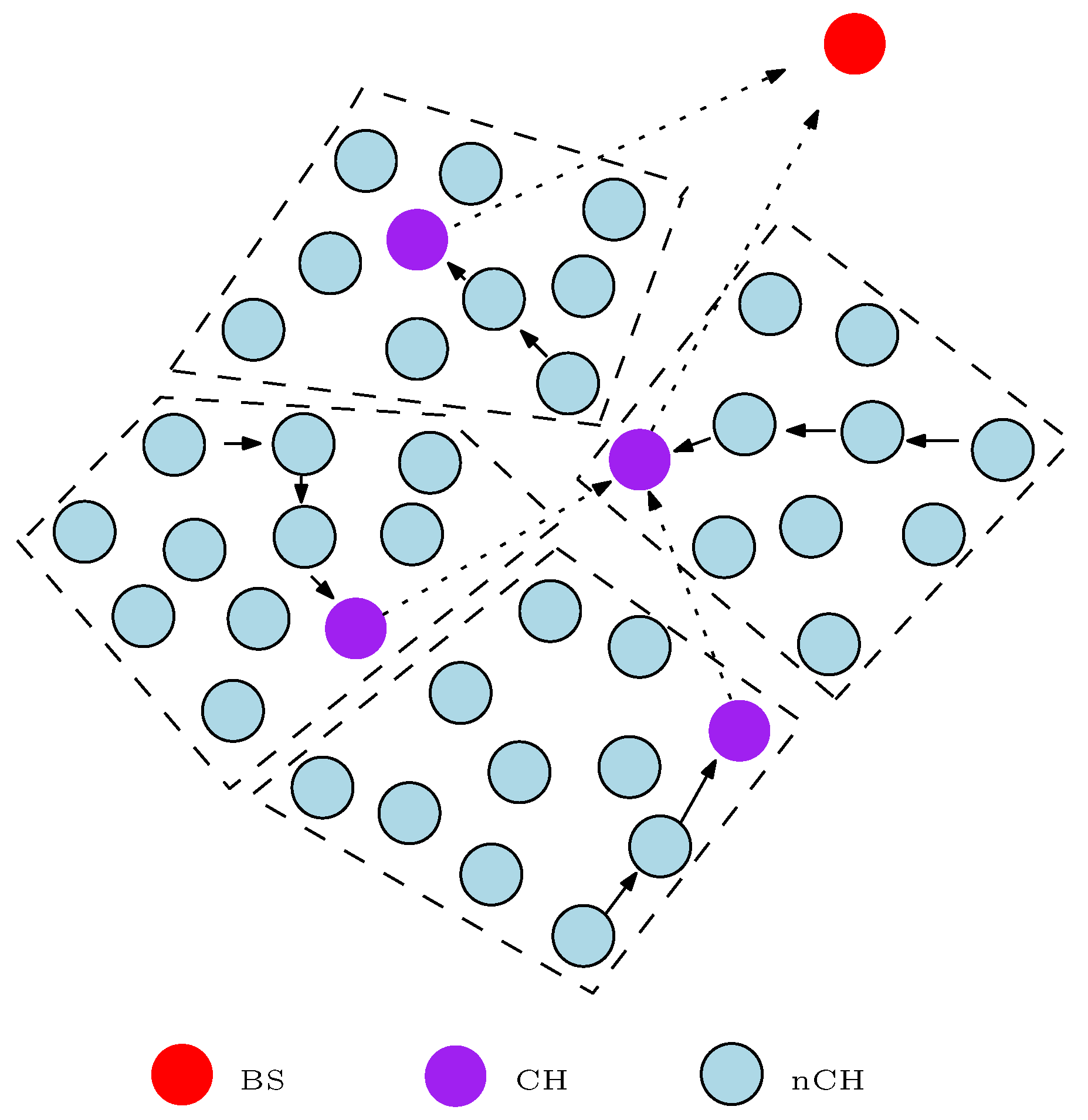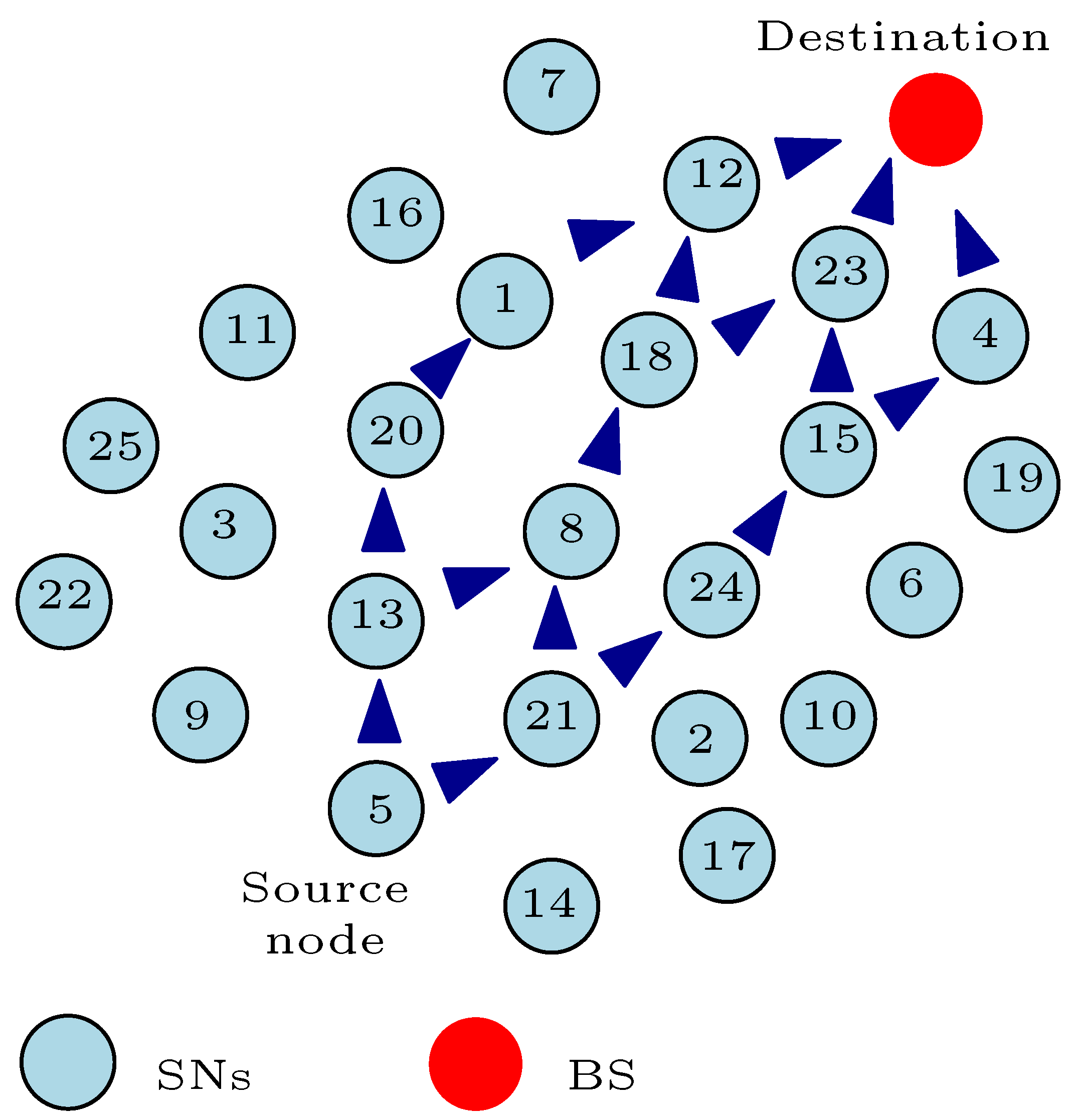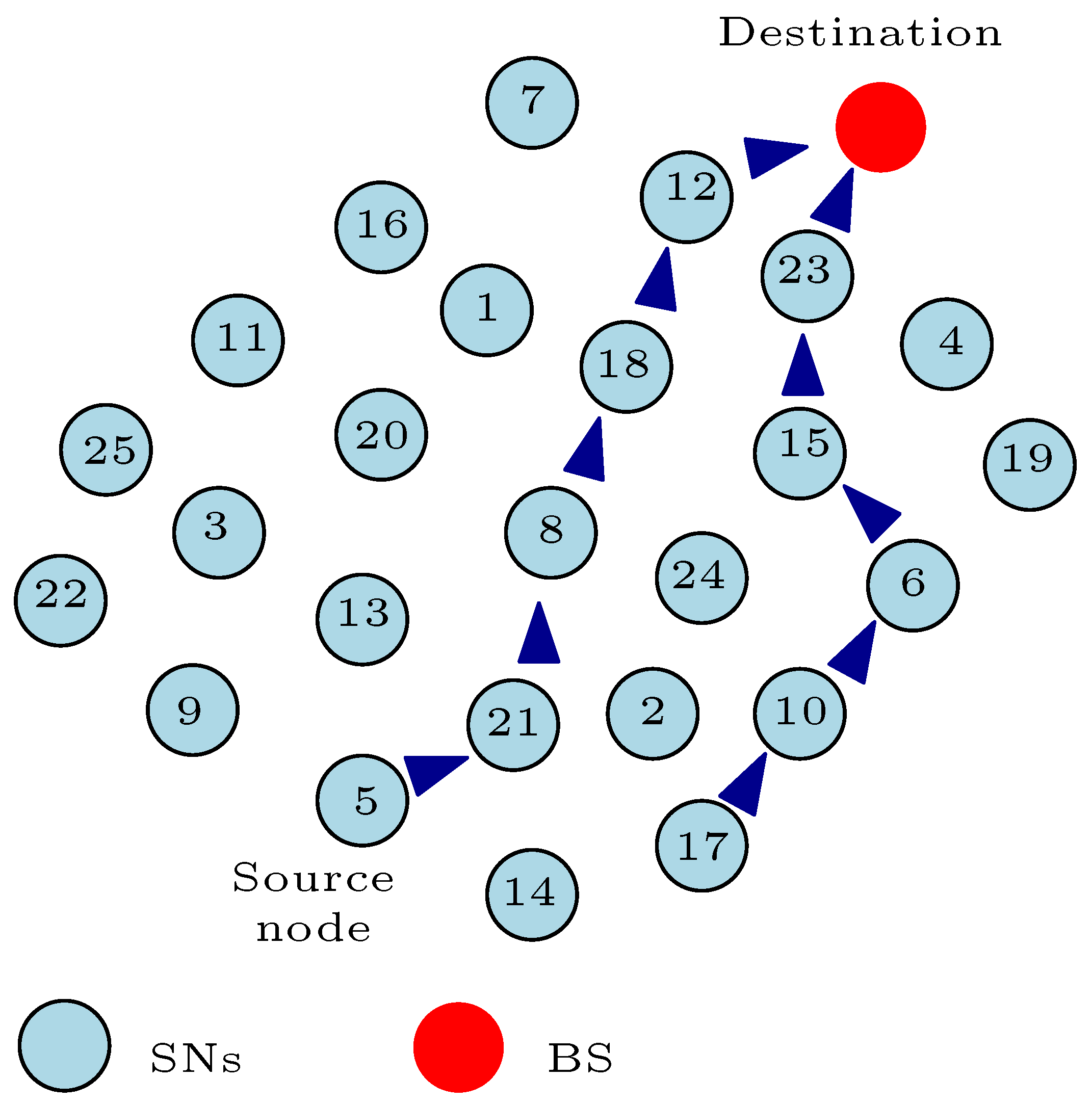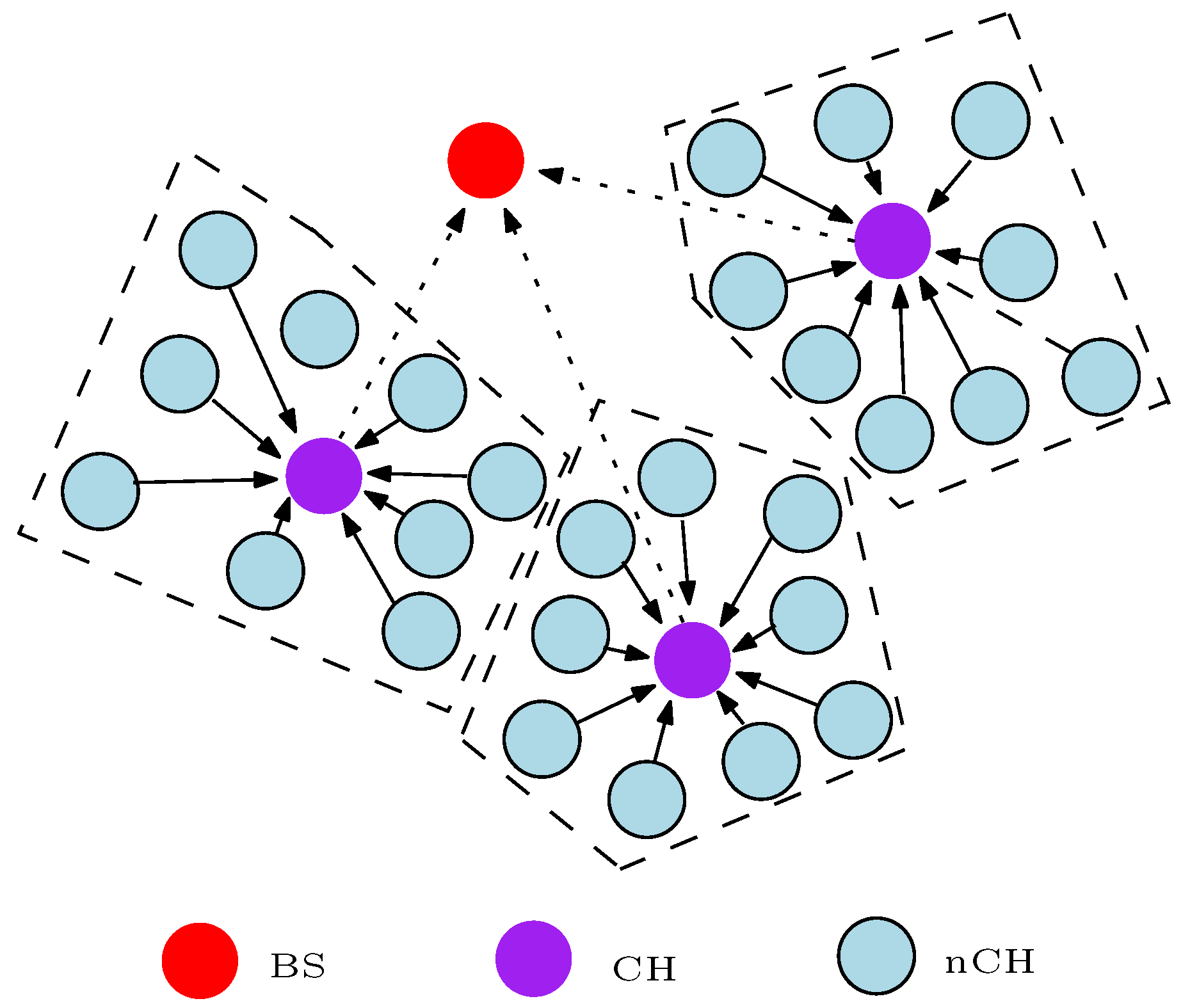In an attempt to use the concept of multi-hop communication to solve the distance problem associated with WSNs, the multi-hop communication technique gave rise to other design issues such as selecting the route with optical hop count to BS and/or the route to the BS with optimal energy consumption (both in terms of the energy consumed by the participating nodes and the total energy dissipated using that route). Therefore, researchers came up with different multi-hop techniques to solve these problems, where the ultimate goal is to conserve the energy in the network. We classify these multi-hop techniques into two main categories: multi-hop clustering technique and load-balanced tree technique. In fact, all the state-of-the-art energy efficient and energy-balanced routing protocols studied fall under any of these multi-hop communication classes, if they are not based on single-hop communication. The concept and principle of these classes of the multi-hop communication method are discussed one after the other. Subsequently, we grouped the surveyed energy efficient and energy-balanced routing protocols accordingly, pinpointing their strengths and weaknesses. Finally, we grouped the surveyed routing protocols based on the solution types or algorithms, and the decision variables used in designing each of these algorithms.
5.1.1. Multi-Hop Clustering Technique
Organising SNs into clusters has been broadly used by researchers to achieve different single and multi-objective optimization problems relating to WSNs. The clustering technique is widely used in designing routing protocols for WSNs because it has many advantages such as scalability, efficient data aggregation, fault-tolerance, latency reduction, robustness, and reduced energy consumption. A clustered WSN mostly contains two sets of nodes: the coordinating nodes usually referred to as the CH, and the member nodes known as the nCH, as shown in
Figure 7. The CHs in the network are used to process the information before sending it to the BS while the nCHs forward the sensed information to their respective CHs. The clustering routing solution can be seen as a two-layer hierarchy where the CH nodes operate in the upper layer while the nCH nodes operate in the lower layer. As such, clustering routing protocols are usually referred to in the literature as hierarchical routing protocols. In some cases, because the CH nodes perform more functions than the nCH nodes, the CH nodes are equipped with a better sensing subsystem, processing subsystem, radio subsystem, and power supply unit in comparison with the nCH nodes. If the components of the CH nodes are different from the nCH nodes, the clustering WSN is referred to as a heterogeneous clustering WSN. Otherwise, researchers refer to the clustering WSN as a homogeneous clustering WSN. A clustering WSN can be based on either the single-hop communication method (refer to
Section 5.2) or multi-hop communication method. In this paper, we refer to a multi-hop clustering WSN as a network whereby the message from the cluster members to their respective CHs and/or the message from the CHs to the BS is transferred using one or more intermediate nodes depending on the travel distance
d. Therefore, we grouped the clustering energy-efficient and energy-balanced routing protocols for WSNs that require any form of intermediate nodes to convey the information either to the CHs or BS under the multi-hop clustering technique.
Multi-hop clustering techniques have been extensively shown to prolong the network lifetime, which is a primary evaluation metric for WSNs. The approach or design decision variables used by different researchers might differ but the clustering concept is unchanged. Basically, in the multi-hop clustering technique, the WSN is clustered as shown in
Figure 7. The number of clusters or the size of the cluster is specified in the routing algorithm. The nCH nodes send the sensed information to their respective CH directly or via one or more relay nodes within their cluster. This clustering mode of communication is regarded as intra-cluster communication. The CHs aggregate all the sensed information from their respective cluster members and forward the aggregated information to the BS, either directly or via one or more relay nodes. In the case of the CHs, the relay nodes can either be a nCH node or a CH node. This means that any of the SNs in the network can serve as a relay node to convey the aggregated message from the CHs to the BS as specified in the routing algorithm. The communication between a CH and other clusters in order to convey the message from its cluster members to the BS is referred to as inter-cluster communication. Moreover, most clustering algorithms divide the network operation into rounds and periodically re-cluster the network in order to rotate the CH duty. The CH nodes consume more energy because they perform more functions in comparison to the nCH nodes. Hence, in order to avoid untimely network partitioning, it is always desirable to rotate the CH duty and select nodes with higher residual energy to operate as the CH in each round. By so doing, the load in the network is uniformly distributed among the SNs. Also, because the source node does not have to convey the
q bit message over a long distance to the destination, the multi-hop clustering technique technically solves the distance problem affiliated with WSN, thereby conserving the energy in the SNs and the total energy in the network.
Despite the numerous advantages offered by the multi-hop clustering routing protocols [
12,
13,
14,
15], designing an energy-efficient and energy-balanced multi-hop clustering routing protocol for WSNs can be a challenging problem. A reliable energy-balanced clustering routing protocol carries some important attributes. Besides the general problems in designing multi-hop routing protocols briefly explained in
Section 4.2, the design of a reliable energy-balanced multi-hop clustering routing protocol has its own peculiar energy dissipation issues, for example, assuming we decide to use a multi-hop clustering routing protocol for the WSN of
Figure 4. The first major load balancing issue is to select the set of nodes that will perform the CH duty. As simple as it may sound, the CH selection phase strongly indicates the network lifetime performance of the proposed clustering routing protocol. As depicted and explained in
Figure 2, if the CH for a particular cluster is inactive or it has completely depleted its battery powered energy, all the SNs in that cluster or sub-network have been segregated from the whole network. The SNs in that cluster will not be able to access the BS for that particular data transmission round despite having sufficient battery energy left. Thus, it is desirable that a SN with sufficient battery energy is always selected as the CH in order to avoid network partitioning and to maintain the full functionality of the network. In this regard, developers of clustering routing protocols pay careful attention in selecting the CH. The CH nodes are selected based on some design decision metrics. Some authors select the CHs based on the residual energy of the SNs [
55,
56,
57,
58,
59,
60,
61,
62,
63,
64,
65,
66,
67,
68,
69,
70,
71,
72,
73,
74,
75,
76,
77,
78,
79,
80,
81,
82]. They choose the SNs with the highest residual energy as the CH nodes, mainly because the CH consumes more energy than the nCH nodes. This approach sounds reasonable but might not be as efficient. If the nodes selected to act as CH are at a distant position from the BS and the clustering routing algorithm assumes that the CH communicates directly with the BS, then the CH node will use up more energy in forwarding the aggregated information from its cluster members to the BS . In [
83,
84,
85,
86,
87,
88], the authors select the CHs based on their proximity to the BS which is computed in the form of a distance metric. It is assumed that since the transmission distance
d plays an important role in the energy dissipation model, the SNs with the shortest distances to the BS will consume less energy when forwarding packets to the BS. These selected SNs serving as CHs might be low on battery energy and if they are used continuously as CHs, they will completely deplete their energy, thereby resulting in untimely network partitioning. The authors in [
89] selected the CHs based on their hop counts to the BS. As explained earlier, a small hop count from the source node to the BS helps to minimise the energy consumption in the network. However, this approach might suffer the same fate as using the shortest distance to the BS approach. Some authors select the CHs randomly based on some set threshold [
90,
91,
92,
93]. They set a threshold such that any SN that does not meet this condition cannot be a CH. The majority of these threshold-based CH selection methods define this threshold based on the estimated average energy or residual energy in the network. Thus, they randomly choose the CH nodes from the SNs that meet the set conditions. Moreover, some literature [
94] firstly divides the network into a virtual grid. Subsequently, they select the gateways or CHs based on their location in the grid. They select the nodes based on their proximity to the boundary of the other grids in the network. This approach tends to prolong the network lifetime because more than one node can be used as gateways. As a result, the gateway function is shared. A setback with this approach is that the nodes acting as gateways are not rotated and might deplete their energy completely at some point during data transmission. As such, the grid(s) will be segregated from the whole network. We classified the literature that assumes that the location of the SNs is known in order to select the CHs under location-awareness (LA). Furthermore, some of the works in the literature select the CHs based on some mathematical formulations derived using a combination of some of these decision variables, thereby finding a balance in the trade-offs by using any of these metrics. In view of the aforementioned,
Table 2 classifies the studied clustering routing protocols based on the common decision variables used in selecting the CH nodes. In the table, RE stands for residual energy, DBS stands for distance to the BS, HCBS stands for hop count to the BS, TB stands for threshold based, and TPBS stands for transmission power to the BS.
Note that the majority of these clustering routing protocols rotate the duty of the CH in order to balance the load in the network. Rotating the duty of the CH has been extensively shown to improve the network lifetime of clustering-based WSNs. Cluster head duty rotation strives to extend the network lifetime and functionality because the functions of the CH are shared among all the SNs in the network. Additionally, this approach avoids untimely network partitioning as shown in
Figure 2.
Table 2 showcases the reviewed routing protocol that offers this important load balancing feature in the multi-hop clustering technique. This CH rotation approach is more common with homogeneous clustering routing protocols as shown in
Table 2. This is because all the SNs in the network assume the same battery energy at initial deployment. Rotating the CH duty in such a scenario will ensure that all the SNs share the heavy task of the CH, thereby evenly distributing the traffic load in the network. On the other hand, some of the heterogeneous clustering routing protocols assume large battery energy for the predefined CH nodes in comparison to the nCH nodes. Since these CH nodes have large battery energy, the CH duty is not rotated at any point. This approach tends to extend the network lifetime and functionality. However, the disadvantage is that, at some point, the CH nodes will completely deplete their battery energy because they perform more energy demanding functions. We classified the clustering routing protocols in which the CH is predefined and that are usually equipped with large battery power in comparison to the nCH nodes. As shown in
Table 2, some authors avoid this disadvantage in heterogeneous clustering routing protocols by rotating the CH duty at some point during the data transmission phase. They define an energy level at which the CH duty is rotated among other SNs in the network. Moreover, some authors [
95,
96,
97,
98] propose a multi-sink technique to solve this problem. In this case, two or more sinks or BSs perform the CH duty. The sinks forward the aggregated information from their cluster members to the main BS. These sinks are powered in the same way as the main BS; thus, they do not have “energy consumption problems”. Although this approach solves the energy consumption issues with CH nodes, we assume it is not practical in reality. A major reason for our assumption is the practical cost implicated in deploying more than one BS to monitor an environment. This is not sustainable considering that WSNs are mostly designed to monitor a small geographical area. In this regard, we classified the studied energy-efficient and energy-balanced clustering routing protocols based on the assumed network infrastructure as a homogeneous (HM) and/or heterogeneous (HT) network. As shown in
Table 2, we classified some algorithms that can be implemented in both heterogeneous and homogeneous network scenarios because the authors verified that their proposed clustering routing protocol is suitable for both scenarios.
Furthermore, in forming the cluster, an important aspect that must be carefully specified in the clustering algorithm is the approach in which the nCH nodes join a cluster. This aspect of the clustering routing algorithm is equally important when choosing the CH nodes. As marked in
Table 2, most literature assumes that the nCH nodes join the cluster with the closest CH node to them in order to reduce the transmission distance. This approach technically reduces the energy consumed by the nCH nodes during data transmission because of the small transmission distance. However, since SNs are randomly placed in the sensor field, an obvious drawback with this approach is that some clusters might have excessive members in comparison with the other clusters. Therefore, the CHs carry more load traffic and will easily deplete all their battery energy. This results in an imbalance in the load distribution in the network. In lieu of this, some authors [
60,
99] strive to distribute the SNs to cover the whole sensor field by assuming that the SNs are aware of their location. This assumption might not be practical in reality because the approach is limited by location services in the network but it enables better sensing or measurement of the physical value as the SNs are evenly distributed around the sensor field [
100]. As a result, different research works are ongoing to solve the node placement problems relating to WSNs [
51,
52]. Moreover, the hop count can be used as a decision variable to specify the cluster that a nCH node joins. As shown in
Table 2, some literature uses the hop count as a yardstick for a nCH node to join a cluster. The nCH node compares the hop count to convey information to every CH in the network and joins the cluster with the smallest hop count. The hop-count approach reduces the energy consumed in receiving and relaying the information from the source node to the CH but will suffer the same setback as the shortest distance approach. Another decision variable used by researchers to specify the cluster that a nCH node joins is the received signal strength or transmission power. In this case, the nCH node estimates the transmission power required to convey a message to all the CH in the network; thus, it joins the cluster with the smallest transmission power. Similarly, this approach will suffer the same setback as the shortest distance approach. Note, from Equation (
4), that the transmission power is a function of the distance between two nodes. This technically means that a nCH node will join a cluster with the closest CH node to it. In addition, in some algorithms, the nCH nodes join clusters based on a probability that depends on their residual energy. However, some literature specifies that the cluster that a nCH node joins is based on some mathematical formulations derived using a combination of one or more decision variable in order to effectively distribute both the inter-cluster and intra-cluster load traffic. In short, the assumptions, concepts, and techniques used by different authors to distribute SNs into clusters play a salient role in effectively balancing the load traffic in the network. As such, in
Table 2, we grouped the surveyed energy-efficient and energy-balanced clustering routing protocols based on the common decision variables used to distribute the nCH nodes into clusters. In the table, DCH stands for distance to the CH, HCCH stands for hop count to the CH, TPCH stands for transmission power to the CH, while the clustering algorithms that do not allot the nCH nodes into clusters using any of the aforementioned decision variables are assigned under “Others”.
Having selected the CH nodes and specified how the nCH nodes should join a cluster, the next load-balanced requirements with the clustering routing protocol technique are (1) how to partition the network into an optimal number of sub-networks or clusters, and (2) the optimal cluster side. Partitioning the WSN into sub-networks is a noteworthy area of research. Some literature simply divides the network randomly into equal sizes while other works attempt to partition the network into different shapes [
60,
69,
121]. Besides, some research work divides the network by assuming a virtual grid-based network structure [
94,
139]. Much more research is still ongoing in order to proffer a solution on how to efficiently divide the WSN into clusters, whereby the ultimate goal is to prolong the network lifetime. In addition, much literature has focused on determining the number of clusters and the optimal cluster size [
75,
86,
101,
108]. These papers strive to distribute the the SNs into clusters so as to have an equal cluster size. A general assumption in some of this literature is that an equal cluster size helps in balancing the traffic load in the network, most especially the intra-cluster traffic load. This might actually be the case but some literature argues otherwise. In [
59,
60,
61,
62,
105,
115,
131,
138], the authors explained how an equal cluster size results in an imbalance in the energy consumption by the SNs in the network. Basically, it is perceived that equally distributing the SNs to clusters is a good approach to balance the intra-cluster traffic load; however, this approach suffers during inter-cluster communications. The clusters closer to the BS consume more energy in receiving and forwarding the load traffic from other distant clusters during inter-cluster communications. This results in an imbalance in the energy consumption during inter-cluster communications and can result in early partitioning of the network. This phenomenon is also termed the energy-hole problem [
53].
An efficient approach used by researchers to mitigate the energy-hole problem while developing a clustering routing protocol is to divide the network into unequal clusters. The size of each cluster depends on how close the cluster is to the BS. That is, the cluster size increases as the distance of the CH nodes from the BS increases. With this in mind, we classified the studied energy-efficient and energy-balanced clustering routing protocol, based on the clustering formation, into equal or unequal cluster size as shown in
Table 3. Besides, some literature strives to mitigate the energy-hole problem by assuming, in the clustering routing protocol, that the BS or sink is mobile. In [
139,
140,
141], the authors assume that the BS moves across the sensor field in order to change the direction of the load traffic. In so doing, it is assumed that all the SNs in the network randomly participate in forwarding the load traffic to the BS; thus, the energy consumption is distributed equally among all the SNs. Chiefly, with the mobile BS approach, the BS moves back and forth around the sensor field so as to collect the aggregated information conveyed from each CH. The mobile sink approach is still a very recent technique used in solving the energy-hole problem but has been shown to protract the network lifetime and functionality [
139,
140,
141]. However, a major setback to this approach is that the BS has to continuously broadcast its current position to the SNs in the network. This results in high network delay due to the complexity in sending the present position of the BS.
Although the cluster formation phases are very important in order to balance the load traffic and subsequently maintain the WSN functionality for a reasonable period, the main focus of this paper is to study how the network load is balanced during the data transmission phase. Having discussed how the aforementioned multi-hop clustering routing protocols carry out the clustering formation steps, we study the decision variables used by these clustering routing protocols in setting up the multi-hop route from the source node to the BS. As explained earlier in
Section 4.2, the proposed approaches used in selecting the route from the source node to the BS play a vital role in balancing the traffic load in the network. This, in turn, conserves the energy of the SNs in the network and the total energy in the network. We divided our classification of these multi-hop clustering routing protocols into two phases. We grouped the clustering routing protocols based on the decision variables used during the intra-cluster communications and the inter-cluster communications as shown in
Table 3. From the table, some literature defines the intra-cluster communication routes or relay node’s chain towards the CH based on the distance usually computed using Equation (
3). Researchers strive to reduce the transmission distance by selecting the nearest node to the CH node. This approach tends to conserve the energy dissipated by the forwarding nodes as a result of the small transmitting distance. However, this approach does not necessarily balance the load in the network. Using the illustration of
Figure 5a, the shortest path or distance route to the CH is not always the most energy-balanced route. Some of these relay nodes along that route might be low on battery energy. Subsequently, such nodes should be protected as much as possible from performing relaying duties, or else, the nodes will deplete their battery energy completely. Moreover, for example, given three nodes X, Y, and Z—assuming the nearest node to X towards the CH is Y, and that node Z is next to node Y—node X will send the sensed information to node Y; node Y will subsequently forward the message to node Z, and so on. Nonetheless, it is possible that node X will conserve the total energy dissipated in the network by transmitting the information directly to node Z. That is, the energy dissipated in transmitting the information from node X→Y and Y→Z is greater than the energy dissipated in transmitting the information directly (without using node Y) from X→Z. As such, the shortest distance route might not always be the most energy-balanced route to the CH. Besides, as shown in
Table 3, some papers define the intra-cluster communication routes based on the hop count or nearest hop to the CH. Similarly, this method conserves the energy in the network—most especially the energy dissipated by the source node—but this method has the same weaknesses as the shortest distance method. In the table, some authors select the most energy-efficient route to the CH. In the algorithms, the authors use the residual energy of the SNs as a key design decision variable in selecting the routes. The algorithms select the SNs with high residual energy to form the relay node’s chain from the source node to the CH. As emphasised with the illustration in
Figure 5b, if the travelling distance in sending the information between the participating nodes toward the CH is unreasonably high, the total energy dissipated in the network will equally increase. In addition, some multi-hop clustering routing algorithms transmit the message from the source node to the CH directly as shown in
Table 3. The authors only use the multi-hop technique during the inter-cluster communications. Note, in
Table 3, all these clustering routing protocols use the multi-hop communication method during either intra-cluster or inter-cluster communications. In most cases, the multi-hop communication method is used in both the intra-cluster and inter-cluster communications. The clustering algorithms studied in this paper that do not use the multi-hop communication method are classified in
Table 6 under single-hop communication. Also, some of the studied clustering algorithms select the relay nodes during the intra-cluster communications based on a probability that depends on two or more of the aforementioned design decision variables. The algorithms attempt to balance the trade-off in selecting the most energy-balanced route to the CH. For instance, as shown in
Table 3, some literature jointly uses the transmitting distance between SNs and the residual energy of the SNs as the input decision variables in selecting the relaying nodes during the intra-cluster communications. In so doing, they reduce, to the nearest minimum, the disadvantages of using either the shortest distance or residual energy only in selecting the relay nodes. The disadvantage with some of these approaches is the high network delay as a result of the complexity in the proposed mathematical formulations. Furthermore, some of these studied clustering routing protocols concentrated more on the clustering formation. Since the focus of these papers is on producing a load-balanced cluster, the authors do not give a clear explanation on the intra-cluster and inter-cluster communications. The mode of communication used in transmitting the sensed information towards the BS in these papers can either be the multi-hop or single-hop communication method. However, we classified these papers under multi-hop communication as shown in
Table 2 and
Table 3. Additionally, as shown in
Table 3, since the design decision variables used for both the intra-cluster and inter-cluster communications in these papers are not mentioned, we grouped the papers under “Cluster only”. Also, we classified the clustering routing protocols that do not use any of these mentioned design decision variables in
Table 3 under “Others”. Lastly, we classified any other design decision variables not mentioned in
Table 3 that are used in selecting the routes to the CH and/or BS, together with those mentioned in
Table 3, under “Others”.
Likewise, we classified the design decision variables used in selecting the route to the BS during the inter-cluster communications. In a similar way to the intra-cluster communication classifications, we grouped the inter-cluster communications under “Direct”, “Residual Energy (RE)”, “Distance”, “Hop count”, and “Others”. Another important factor to be considered during the inter-cluster communication phase is the tier of the SNs acting as part of the relay node’s chain in forwarding the aggregated information from a CH node to the BS. Since clustering WSNs are regarded as a two-tier hierarchical network, the tier of the node used to form the relay node’s chain towards the BS plays a vital role in balancing the load traffic in the network. Some authors use the upper tier nodes (CH nodes) only to form the relay node’s chain towards the BS. Although this approach is better than sending the aggregated data directly over a large distance to the BS, the approach tends to increase the work load of the CH nodes. In this case, beside aggregating and forwarding the information from their respective cluster members, the CH nodes are given the sole responsibility of also serving as relay nodes in forwarding the aggregated information to the BS. Accordingly, this increases the duty of the CH nodes, thereby increasing the energy dissipated by the CH nodes in that particular data transmission round. Moreover, the CH nodes close to the BS will consume more energy because they always have to participate in the relaying duties. On the other hand, since the CH nodes perform more duties in comparison to the nCH nodes, the lower tier nodes (nCH nodes) can be used to form the relay node’s chain towards the BS. As shown in
Table 3, this approach has not been used but we emphasised that this approach will reduce the burden of the CH nodes in relaying the message to the BS. Therefore, we assumed that this approach can be considered in designing multi-hop clustering routing protocols in the future. Moreover, some authors share the relaying duties between the two-tier nodes. Both the CH nodes and the nCH nodes can act as a relay node in transmitting the aggregated information towards the BS depending on the design decision variables used. This approach tends to prolong the network lifetime performance as compared to using only the CH nodes. However, if the design decision variables are not carefully specified in the clustering algorithm, the SNs acting as CH nodes might frequently participate in the relaying duties. Thus, this approach will suffer the same setback as using only the CH nodes. With regards to this, we grouped the studied clustering routing protocols that employ the multi-hop method during the inter-cluster communication phase based on the nodes performing the relaying duties toward the BS. As shown in
Table 3, we grouped the relay nodes used during the inter-cluster communication phase under “CHtoBS”.
Finally, in
Table 3, we grouped the studied multi-hop clustering routing protocols based on the solution types or algorithms used. Optimization plays a vital role in WSNs. Generally, an optimization problem comprises of the input decision variables, constraints, objective functions and the outputs. In most of the optimization problems associated with WSNs, these component parts can be merged with numerous dissimilar combinations resulting in different kinds of optimization problems. As such, there is no single algorithm that proffers a solution to the different optimization problems affiliated with WSNs [
54]; this is with respect to the energy consumption issues with WSNs, where the major objective function is to minimise the energy consumption in the SNs in the network and the total energy in the network. We grouped the studied multi-hop clustering routing protocols based on optimization solution types or algorithms as shown in
Table 3. As illustrated in
Table 3, “B” stands for bio-inspired-based algorithms, “E” stands for evolutionary-based algorithms, “G” stands for game theory-based algorithms, “H” stands for heuristic-based algorithms, “L” stands for linear programming-based algorithms,“M” stands for meta-heuristic-based algorithms, and “S” stands for stochastic-based algorithms.
